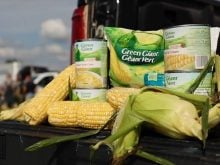Following successful in-field trials in various crops in 2021, Corteva Agriscience is using the N-fixing ‘biostimulant’ Utrisha N as the first product in its planned portfolio of biologicals in North America.
Through a novel species of the methylobacterium genus, the foliar-applied Utrisha N enters the plant’s leaves through the stomata and converts atmospheric N into a nutrient available for crop growth. The eastern Canada tech sheet for the product advises application in canola at the four-leaf bolting stage, cereals at the four-leaf jointing stage, and corn and soybeans between stages V4 to V8.
Corteva Eastern Canada agronomist Marc Maisonneuve said in this part of the country he expects corn growers will be most attracted to the product’s potential.
Read Also

Packer buys Green Giant, Le Sieur veg brands from U.S. owner
A Quebec-based processor’s deal to buy the Green Giant and Le Sieur packaged and frozen vegetable brands in Canada from a U.S. owner clarifies the status of two popular retail brands grown by Canadian farmers.
“That’s because the needs for N are much more in corn – especially when you go from the vegetative stage to the reproductive stage.”
Why it matters: With fertilizer prices rising sharply and expected to continue in that trend, crop farmers are looking for ways to limit their need for supplemental N.
The range of products known as biologicals – naturally occurring microbes that are promoted as pest repellants, growth promoters or soil fumigants – are in most cases relatively new to the conventional crop input market in North America. While soil-based, seed-applied microbial inoculants for N fixation are more common, in-crop products have been marketed mainly into organic farming circles and sold mainly by smaller-scale companies.
With rising awareness of the fossil fuel consumption required for conventional pesticides and synthetic fertilizers, however, mainstream input manufacturers are getting into the biologicals game.
Add to this the recent increase in costs for conventional inputs, particularly synthetic N, and a product like Utrisha N is sure to inspire interest. Corteva’s Product Manager for Seed Applied Technology, Fungicides and Nitrogen Management, Kirsten Ratzlaff, says Utrisha N is being promoted as a supplemental source to be used in conjunction with an existing fertilizer application regime. And Maisonneuve stressed they’re not suggesting crop advisors change their recommendations about synthetic N for growers using the new product.
But given Utrisha N’s persistence later in the season and through dry conditions, he agreed it could have some potential for decreasing a crop’s season-long needs.
“It seems like it has just been one curveball after another affecting that urea supply,” he said. “And this is a potential solution.”
In 2020, UK-based Azotic introduced Envita, an in-furrow applied N-fixer derived from a bacterium first discovered in sugarcane. With this year’s release of Utrisha N, Corteva aims to compete in the marketplace with a product derived from a different bacterium that Maisonneuve says will be attractive to growers due to its ease of storage, mixing and use, as well as its wide time window for application.
“I wouldn’t suggest keeping it in the back of a canopied truck for weeks,” he said of the product’s shelf life. But he saw growers participating in last year’s in-field trials who kept the crystalline powder for an extended period before being able to easily tank-mix it with other crop protection inputs.
“It’s certainly not as tricky a product as some that are being talked about or that have already been introduced,” he said.
Maisonneuve added Corteva has compiled a long list of potential tank mixes for which Utrisha N is compatible. “That (the need for separate applications of separate products) can be a big deterrent if you’re trying to limit passes over the field.”
Ratzlaff told Farmtario the company ran approximately 200 field trials in Canada in 2021 and expects to continue with even more in 2022. “Our positioning through the winter has been very strong,” she said. “We’ve had a lot of growers, including a lot who didn’t participate last year, sticking their hands up wanting to use the product.”
Those trials, as well as even more in the U.S., she continued, provided “a pretty substantial data set” of evidence that Utrisha N could boost yields due to its provision of N beyond the time it typically can be applied in fertilizer form.
“What we’re learning is that we can diversify our N support,” particularly in the mid-to-late growth stage of major crops.
Ratzlaff added that “we’re starting to see the trials stretch into some specialty crops.” And Corteva has an application to the Organic Materials Review Institute (OMRI) seeking approval for use on certified organic farms – a ruling from which she hopes will be returned in time for the 2022 growing season.
Utrisha N represents US-based Corteva’s first entry into the North American biologicals marketplace but Ratzlaff promises it won’t be the last. A biologicals section of the company’s website was launched in conjunction with Utrisha N’s release, promising to “complement existing practices (and) help you tackle the challenges of resistance management, enhance ROI and profitability, and preserve your land for the future.”
The company has created a global team devoted to researching, developing and marketing additional products into that portfolio.
Ratzlaff wouldn’t say what’s next on Corteva’s biologicals agenda but she explained there will be three lines of products: biostimulants like Utrisha N, biocontrols using naturally-occurring pest repellants, and “products in the pheromone space.”
She believes Corteva is in line with the thinking of many North American farmers as they launch the new line of products.
“Farmers are ready for this,” she commented. “They’re ready for the biological market and ready to see how it fits on their farms.”













